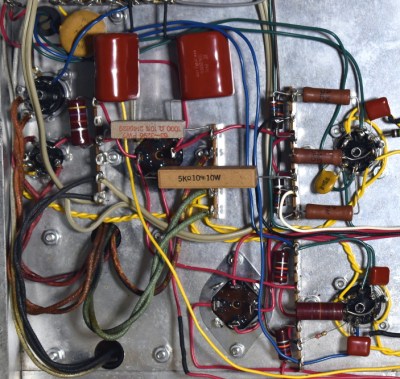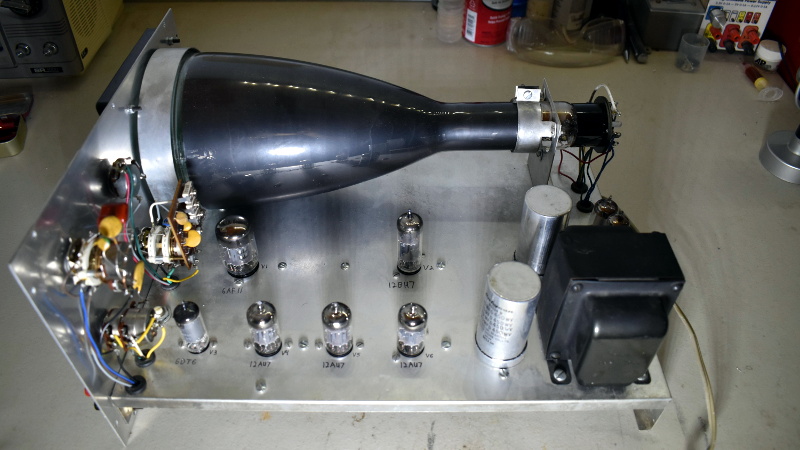We’ll admit it, in an era when you can get a four channel digital storage oscilloscope with protocol decoding for a few hundred bucks, it can be hard not to see the appeal of analog CRT scopes from decades past. Sure they’re heavy, harder to use, and less capable, but they just look so cool. Who could say no to having one of these classic pieces of gear on their bench?
 [Cody Nybo] certainly couldn’t. Despite the fact that he already has a digital scope, he couldn’t pass up the chance to add a Bell & Howell Schools Model 34 from circa 1973 to his collection. It needed a bit of TLC before it could be brought back into service, but now it’s all fixed up and ready to put in some work. Not bad for a piece of gear with nearly a half-century on the clock.
[Cody Nybo] certainly couldn’t. Despite the fact that he already has a digital scope, he couldn’t pass up the chance to add a Bell & Howell Schools Model 34 from circa 1973 to his collection. It needed a bit of TLC before it could be brought back into service, but now it’s all fixed up and ready to put in some work. Not bad for a piece of gear with nearly a half-century on the clock.
The restoration of the Model 34 was aided by the fact that [Cody] got the original manual and schematics for the scope in the deal, which he was kind enough to scan and upload for the rest of the class to enjoy. Those of you who have worked on older electronics can already guess where the scope needed the most love: all the capacitors needed to be swapped out for fresh ones. He also found a few resistors that were out of spec, and the occasional bad solder joint here and there.
Even if you’re not looking to repair your own middle-aged oscilloscope, his pictures of the inside of Model 34 are fascinating. The scope was sold as a kit, so the construction is surprisingly simple and almost entirely point-to-point. Of course, there’s something of a trade-off at work: [Cody] says it won’t display much more than 2.5 MHz before things start getting wonky. But then again, that’s a more than reasonable frequency ceiling for audio work and most hobbyist projects.
Oscilloscopes have come a long way since the days when they had to draw out their readings on a piece of paper. While newer devices have all but buried the classic analog scope, a beauty like this would still have a place of honor in our lab.
















I could very easily pass on a junker like that. Bench space for me at any rate is valuable. With the raw amount of stuff I have I don’t think one of those old scopes would even rate indoor storage. Again, save that for the better stuff. On the flip side, if it makes him happy, that’s all that counts.
I used to have a Tektronix 545A (as well as other old Tek stuff). Beautiful old ‘scope, 30MHz, with a wonderful delaying timebase, lots of different plug-ins, including a differential plug-in that I miss. Still, it was just too old, took up *way* too much bench space, put out *way* too much heat, was ready for an epic re-capping (unbelievable part count for a piece of tube gear, amazing that they were so reliable) and other than that it just can’t do much of what my DSO can do. I still miss it though.
I had a 545 too and a bunch of plugins for it, and the scope cart to truck it around. It was a nice machine on a cold winter night for sure. And amazing what they did considering what the part count was. The thing had about enough tubes in it to make one modern opamp…
About 100 tubes if I remember. I repaired some chopper – stabilized tube opamps in that period. They were old even in the early ’80s.
When I was a teenager in the ’70s I had an Eico ‘scope that was similar to this Bell & Howell. I made a triggered time base from a 555 and some other parts, that made it much more useable. I also made a dual-trace adaptor (chopped, no alt). Its huge limitations (beside low bandwidth) were that it was AC coupled only and did not have a calibrated vertical. It was better than nothing until I got a Tek 535 (not an A) at a hamfest and my father helped me fix and calibrate it.
Lol, I reported your comment by mistake. Hackaday PLEASE move those buttons from the right hand side, they are too easy to hit accidentally while you are scrolling
And we need an upvote or like button, too. Oh, and a delete, and an edit, while you’re making upgrades.
I used to have a Tek 475. Very nice scope, and I quite agree that an analog scope looks much cooler than a modern digital one. I do not agree about the harder to use though – I’d actually say easier, because everything is right there and not hidden in some menu. I sold it a while back, because it wasn’t particularly useful when working with intermittent signals, and I couldn’t justify keeping it and a digital scope for just a hobby.
Gave away my HP130C to a ham a few years ago. Awesome hunk of gear, but I had no use. Bandwidth limitation, power consumption, and shear mass and footprint, made it very easy for me to let it go. I have a lot of older gear, some that is more “collectable” than useful, but the scope was too much.
Did similar with a Tek digital mainframe with 100MHz and 1GHz input stages and 1GHz timebase plugins, as well as several others, including a delay unit, remote keypad (it had something like 40 keys) storage unit (1.44Mb floppys…. WOW! Who could ever need that much storage on a ‘scope!) n-channel logic probe plugin (16? I think) to 1GHz, and a few other plugings I can’t recall. Tried giving it away for better than a year. Scrapped it in the end. I only regret not keeping the cart.
Should probably note that I don still have my first scope, and it works fine. Heathkit. I have no clue where the manual for it is, though. Due for another recapping soon. Last time was maybe 1990.
I had a DeVry Oscilloscope that was a lot better than that! Wait! They were the same scope.
Reminds me of my 10MHz analog one…. and another story where the display was weak, but actually it was not a worn out tube itself. heck i should even have everything here to redo a full calibration. Its nothing expensive, but sounds like a fun project
Now I’m tempted to restore my old Eico that I built in the early ’60s. It’s been collecting dust in the rafters of my garage for many years.
Ha! I was given one of these last year! All seems to work, except the horizontal sweep. Very interested in your process and manuals!
I’m a graduate of the Hell & Bowell school of the late 70’s. At that time they were supplied by kits from Heathkit.
I worked at the Air Force Research Lab and all the military used their GI Bill to learn TV repair (some had Ph. D.’s in electronics, but I only had a B.E.E at the time). We all raced through the course to get the free TV at the end. I built mine into the wall (too cheap to buy the cabinet) and kept it alive for years by getting parts from non-working TVs. The HVPS would blow up due to dirt collecting on the feedback line to the HV regulator, but that’s another story.
I still have the scope. It’s solid state except for the boob tube but suffers from typical Heathkit cheap parts (20% resistors). But it outlasted a Tek and an HP.
Really is beautiful and in good shape. Usually beat senseless , knobs missing/broken, faceplate and numbering scratched to unreadable, oxidation, tubes missing or broken, and rust excessively unreasonable to fix. So simple and elegant for being simple.
I keep a beast alive from late 60’s. Tek546. Let it out of storage to scare /confuse newbies and screw with visitors. Ya its a portable scope. Has handles on top. Ha.
Mine is also an excellent space heater but price of replacement tubes limits that use.
Is it possible to get a new link the the schematic and assembly guide? I have the same model but have not been able to find a good copy of either. I would appreciate it if you could send send me a email in regards to it or just to let me know you replied here. My email smolsfbean@gmail.com thank you very much.
I have about 12 scopes, some old, low band width, some high, over 100 Mhz, and a 100 Mhz digital scope. Some are AC coupled and most are AC/DC coupled. I have 3 military scopes,
OS-8e/u series, AC?DC coupled up to 2Mhz.
Hello
I tried to download the assemble manuals 1 and 2 but was unable. I got an error as (unable to find).
I check the URL twice
I just uncovered my old HealthKit and would like help on what not to do! I don’t want to screw it up by plugging it in and burning stuff up. What should be checked first?
Also, any manual for it would be appreciated.
Old and heavy but looks great, like new.
Thanks for any help